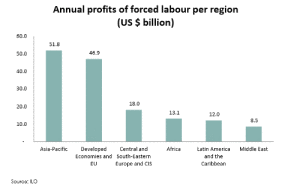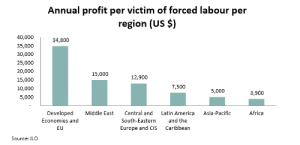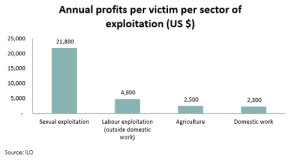Forced Labor Generates $150 Billion in Annual Profits
(ILO News) – Forced labor in the private economy generates US$ 150 billion in illegal profits per year, about three times more than previously estimated, according to a new report from the International Labor Organization (ILO).
The ILO report, Profits and Poverty: The Economics of Forced Labor , said two thirds of the estimated total of US$ 150 billion, or US$ 99 billion, came from commercial sexual exploitation, while another US$ 51 billion resulted from forced economic exploitation, including domestic work, agriculture and other economic activities.
“This new report takes our understanding of trafficking, forced labor and modern slavery to a new level,” said ILO Director-General Guy Ryder. “Forced labour is bad for business and development and especially for its victims. Our new report adds new urgency to our efforts to eradicate this fundamentally evil, but hugely profitable practice as soon as possible.”
The new figure is based on ILO data published in 2012 that estimated the number of people in forced labor, trafficking and modern slavery at 21 million.
Significantly, the new estimate indicates that more than half of the people in forced labor are women and girls, primarily in commercial sexual exploitation and domestic work, while men and boys were primarily in forced economic exploitation in agriculture, construction, and mining.
The breakdown of profits generated by forced economic exploitation is as follows:
- US$ 34 billion in construction, manufacturing, mining and utilities
- US$ 9 billion in agriculture, including forestry and fishing
- US$ 8 billion saved by private households by not paying or underpaying domestic workers held in forced labor.
The report highlights income shocks and poverty as the main economic factors that push individuals into forced labor. Other factors contributing to risk and vulnerability include lack of education, illiteracy, gender and migration.
“While progress is being made in reducing state-imposed forced labor, we must now focus on the socio-economic factors that make people vulnerable to forced labor in the private sector,” said Beate Andrees, head of the ILO’s Special Action Programme to Combat Forced Labor.
Andrees called for a series of measures aimed at reducing vulnerability to forced labor including:
- Bolstering social protection floors to prevent poor households from abusive lending or indenture in the event of sudden income shocks;
- Investing in education and skills training to fortify job opportunities for vulnerable workers;
- Promoting a rights-based approach to migration to prevent irregular employment and abuse of migrant workers; and
- Supporting the organization of workers, including in sectors and industries vulnerable to forced labour.
“If we want to make a significant change in the lives of the 21 million men, women and children in forced labour, we need to take concrete and immediate action,” the ILO Director-General said. “That means working with governments to strengthen law, policy and enforcement, with employers to strengthen their due diligence against forced labour, including in their supply chains, and with trade unions to represent and empower those at risk.”







Leave a Reply
Want to join the discussion?Feel free to contribute!